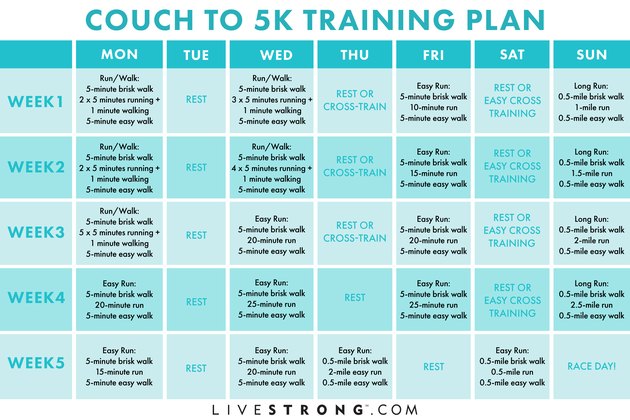
 use this beginner training plan to change from zero activity to hero. (image: Livestrong. Com)
use this beginner training plan to change from zero activity to hero. (image: Livestrong. Com) 5K training program for beginners
your goal: complete your first 5K
if you have run, walk or run for at least two to three days a week, be prepared. overview: has four days of running time, including rest or cross training. &"Every other day's schedule can minimize the risk of injury and provide mental rest," castor said. Alternate running days also ensure that the rest days are on weekdays and weekends, so that the program can adapt to your work and family life. time and mileage: timing is easier than timing, so training on weekdays is done by clock. Sunday runs are in miles, so you can start to understand the speed of each mile. &Kastor says mile training is also a way to build confidence. &Knowing how far you've run ensures you'll be able to finish the race on race day. &Quote; warm up / cool down: each run starts with a 5-minute brisk walk and ends with a 5-minute brisk walk. You're going to want to skip this - but not! Warming up and cooling down can allow your body to safely get in and out of exercise, castor said. They also increase your total training time, which helps you build the endurance you need on race day. How to use this training calendar Here & 39; is the classification of main training types and some tips for making full use of training. intensity / pace: all runs should be done in an easy way - conversation pace, 60% to 65% of maximum heart rate, or 5% of the perceived hike scale (1 to 10). Running faster and harder increases the risk of injury, castor said. Use your first race to build endurance, and then you can start racing at speed if you want. running / walking: in the first two weeks, the training will alternate running and walking for one minute. So a 2 x 5 minute run, a 1 minute walk means you'll run for 5 minutes, walk for 1 minute, and then repeat. Similarly, 3 x 5 means you do it three times. Don't think too little about walking time. Nearly 80% of runners get hurt, and walking rest is a strategic tool to build a safe distance. In addition, they make it easier and more enjoyable to adapt to running. easy running: these workouts are steady runs at comfortable speeds. If you're trying to finish, slow down. long run: long run lays the foundation for long run: endurance. They are the most important exercise for road racing. If you don't live near a sidewalk marked with miles, measure the distance in your car, go to the track (4 laps equals 1 mile), use the U.S. track and field mapping tool or download a smartphone app like mapmyrun. You can also run on the treadmill, but you need to make sure that many of your runs are done outdoors to get closer to the conditions of the simulated competition ground. Cross training is a choice. You can do yoga, swim, bike, go to the gym or whatever you like. Increased exercise will boost your run - keep it light the day before the long run so you don't start this critical exercise tired. days of the week: plans sometimes change. If you need to reschedule your training day, do it. You just need to move the day forward or backward, or try your best to keep the plan every other day. Do you know? By training and completing the first 3.1 mile road race, you'll be joining 2.6 million runners. Source: running USA provides other useful resources for your first 5K run From what to eat to how strength training can help you run faster and prevent injury, here are some additional guidelines you & 39; ll want to read before you reach the starting line.
